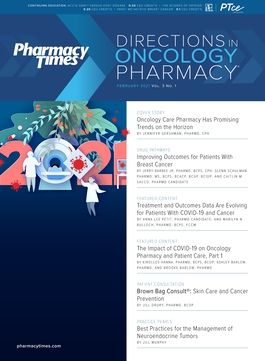Publication
Article
Pharmacy Practice in Focus: Oncology
Statins Are a Standard Treatment Component for Certain Patients With Cancer
Author(s):
Key Takeaways
- Statins are integrated into cancer treatment to prevent cardiotoxicity and enhance antitumor activity, especially in patients with increased risk factors.
- Pravastatin is preferred due to minimal drug interactions and tolerability, aiding in reducing cancer incidence and improving treatment outcomes.
Statins have become a standard part of treatment for certain patients with cancer to prevent cardiotoxicity and promote antitumor activity.
The connection between cancer and cardiovascular disease has been well established by investigators in the field, explained Jessica Shank Coviello, DNP, APRN, ANP-BC, during a session at the Advanced Practitioner Society for Hematology and Oncology annual meeting, 2020 JADPRO Live Virtual. For this reason, statins have become a standard part of treatment for certain patients with cancer to prevent cardiotoxicity and promote antitumor activity.
It is important, however, when planning treatment with chemotherapy to consider some key risk factors for chemotherapy-related cardiotoxicity, according to Coviello, an associate professor at Yale University School of Nursing and a nurse practitioner in cardio-oncology at Smilow Cancer Hospital at Yale New Haven, both in Connecticut. Such risk factors include current myocardial disease, demographics, previous cardiotoxic cancer treatment, and lifestyle. For patients at increased risk for cardiotoxicity, statins may be an important treatment consideration.
Previously in practice, if patients started chemotherapy, they were immediately taken off statin treatment. The thought was, at the time, that statins could interfere with liver function.
Statins have been shown to have a unique mechanism, enabling them to play a role in cancer treatment, noted Coviello. Not only do they have antioxidant properties, but they also promote antitumor activity.
During the JADPRO session, Kejal Amin, PharmD, MBA, BCOP, a clinical oncology pharmacist at Smilow Cancer Hospital at Yale New Haven, explained that patients on statins at baseline had lower incidence of lung cancer by 45% and also a lower incidence of breast cancer.
“Some patients have to be on statins in combination,” Amin said. “We found that for patients with hepatocellular carcinoma [who] were on chemotherapy and a statin, the hepatic lesion actually shrank [more] than [for] those who [were] just treated with chemotherapy.”
Coviello noted that in her experience, patients with hepatic lesions seemed to understand the critical importance of statins in their combination treatment of statins and chemotherapy, which motivated them to more strictly adhere to their statin therapy.
“Those were always the first patients [who] had their statins stocked—those who had hepatic involvement,” Coviello said.
Amin noted that for patients with prostate cancer, keeping them on a statin while giving them radiation results in a lower incidence of renal toxicity. In this way, statins not only prevent some cancers but also play a role in better prognosis of some malignancies.
Many statins are on the market today, but Amin said her practice usually uses pravastatin (Pravachol; Bristol Myers Squibb) because it has minimal drug interactions, is well tolerated, and has the potential for less hepatic and renal dysfunction.
“When we do use a statin, that is usually the one we try to go for,” Amin said. “In my experience as a hematology pharmacist, when we used to have patients admitted, we would automatically switch them over to pravastatin before we started chemotherapy, just to prevent any drug interaction from occurring.”
Amin also noted that during clinical trials, test statins are often given to patients at very high doses but that in practice, patients could not tolerate statins at such high doses because of the potential for drug interactions, adverse effects, and myopathy. This is something to consider, she said, when treating patients with cancer with both statins and chemotherapy, adding that at her practice, statins have become a standard part of treatment for certain patients with cancer.
“I have seen us using statins more and more,” she said. “And specifically, we have been using pravastatin.”
REFERENCE
Coviello JS, Amin K. Cardio-oncology: the intersection between cardiovascular disease and cancer. Presented at: 2020 Journal of the Advanced Practitioner in Oncology Live Virtual; October 15-23, 2020; virtual.







